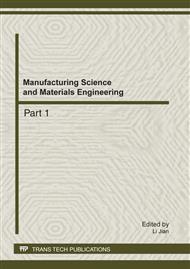p.395
p.401
p.408
p.412
p.418
p.424
p.430
p.437
p.442
A Liquid Level Measuring Device for a Tank Based on Image Senor
Abstract:
A non-contact liquid level measuring system is designed based on image processing technology, and it consists of three parts: a COMS camera, a laser source, and a PC. The work principle of the device is: the laser beam from the laser source is irradiated to the liquid at a certain angle, and the image of the tank’s interior is picked up by the CMOS camera; then the light spot on the liquid surface is extracted by the technology of image processing; Through the center of the light spot, the information about liquid-level can be obtained. The model of the measurement system is proposed in the paper, and the method of the calibration is given by using the least square algorithm. Experiments tests that the liquid level measuring device can be used in strict and adverse environment.
Info:
Periodical:
Pages:
418-423
Citation:
Online since:
January 2012
Authors:
Price:
Сopyright:
© 2012 Trans Tech Publications Ltd. All Rights Reserved
Share:
Citation:


